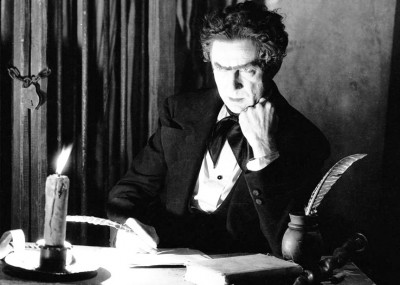
This Screening Room is something of an experiment. It’s the result of me having started keeping a not-entirely-comprehensive diary of movies I’ve watched that I didn’t have to review in some fashion—and which I think it reasonably improbable I’ll ever have occasion to review. The results are more reactions than reviews, but I thought they might be of some interest. They might ultimately be of some referential value, too, if someone in the technical department of the paper can come up with some method of cataloguing them in a separate archive alphabetically—and if I keep doing them. In any case, here are my short reviews on ten movies—mustered in alphabetical order.
I should perhaps note that this are pretty much unfiltered—except in terms of language, since the paper worries a bit about that sort of thing. These are barebones reactions to the movies that have—for one reason or another—come under my gaze in the past few weeks. The collection has no theme and is eclectic in the extreme. A great deal of it—in fact, most of it—is strictly the result of the TCM programmers. It’s pretty rare that I get the chance to watch DVDs that I don’t have to watch, but it’s not so rare that I’ll watch something if I bump into it on TCM. That allows me the illusion that I’m not watching something when I ought to be attending to other matters, since I didn’t plan on it. You see, it was forced on me. I had nothing to do with it. (I have yet to meet the writer who wasn’t expert at finding reasons not to be writing—none of which are ever his or her fault.)

The Beyond (1983). I’m not sure why I bothered sitting through this highly-regarded (in some quarters) Lucio Fulci opus—except that there were other things I ought to have been doing, making the distraction irresistible. I saw it back in the 1990s when someone sent me a copy taken from a laserdisc release. I thought it was pretty lousy then and it hasn’t improved. The gore is cheesy (though the movie perhaps redefines the term “eye-popping”), it’s not scary and it’s virtually incoherent. OK, it has some atmosphere, but that’s about it. It also has the world’s dumbest hero. He figures out early on during the climax that the lurching dead only expire if you shoot them in the head, but he keeps right on wasting his rapidly diminishing ammo by trying at least two body shots before aiming for the head. Pretty completely a waste of time.
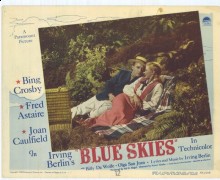
Blue Skies (1946). Stuart Heisler’s Blue Skies has always disappointed me. I came to the film backwards, having been introduced to it by finding my parents’ soundtrack album of 78s and hearing the bulk of the songs long before I saw the film. In fact, I still find myself getting “A Couple of Song and Dance Men” stuck in my head. Well, I tried the movie again recently and I still don’t like it. It was intended to duplicate the success of Holiday Inn (1942) and in Technicolor no less. The problem is that Holiday Inn is fun. This is a drag. It’s a soapy story that finds Joan Caufield in love with Bing, who’s a pretty unstable guy with a penchant for creating successful nightclubs and selling them in order to pursue some better idea. Naturally, she marries him, thinking he’ll change. He doesn’t. She divorces him. Poor Fred Astaire stands around hoping to pick up the pieces, but it just doesn’t work, so he gets drunk and is injured in a fall during a dance number. Not a lot of laughs. The film was supposed to be directed by Mark Sandrich, who’d made Holiday Inn, but he had a heart attack and died early in production. He might have helped, but that script was probably insurmountable. Incredibly, my parents sat through it twice in 1946 to see Billy De Wolfe’s “Mrs. Murgatroyd” sketch (which occurs about 10 minutes from the end!) a second time. Why, I cannot imagine.
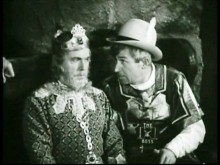
A Connecticut Yankee (1931). Not as well-known as the 1949 musical version with Bing Crosby, this 1931 Will Rogers take on Mark Twain’s story shares something with the later film: it’s more a star vehicle than a serious attempt to bring Twain to the screen. However, there’s something fitting about it here, since Rogers was just as much an American humorist in his own right as Twain was. It’s a nice match—even if Rogers sounds very little like he came from Connecticut. The story is basically the same—the title character finding himself transported back in time to King Arthur’s court—though it’s been updated and tailored to its star. Rogers’ Hank Martin isn’t a blacksmith, but a radio store operator and fledgling broadcaster, who is sent back in time after being knocked unconscious by a suit of armour. He gamely attempts to conform to the language of the day—“Canst telleth me where in the helleth I am?”—but ends up on the wrong side of Merlin the magician (Brandon Hurst) and King Arthur (William Farnum) and is sentenced to burn at the stake. With the help of a convenient eclipse—which he claims to have caused with the then topical magic words, “Prosperity! Farm relief! Freedom for Ireland! And light wines and beer!”—he saves himself and the juvenile lead (Frank Albertson). He’s made Sir Boss and proceeds to modernize Camelot, but runs afoul of Merlin and the evil Morgan le Fay (Myrna Loy). A great picture? No, but it’s an agreeable comedy and a nice showcase for Rogers. For reasons I cannot fathom—especially since the film was given a VHS release—this did not appear in either of Fox’s box sets of Will Rogers movies. Added plus, it introduced the useful insult, “Thou art filled with the juice of the prune.”
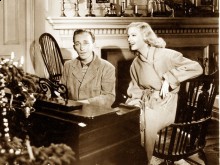
Holiday Inn (1942). The venerable Christmas classic—where Bing Crosby introduced “White Christmas”—is really the movie equivalent of an all-purpose greeting card. We not only get Christmas, but New Years, Lincoln’s birthday, Valentine’s Day, Washington’s birthday, Easter, the Fourth of July and Thanksgiving. (The blackface number for Lincoln’s birthday can be troublesome for people who can’t place things in the context of the era in which they were made.) It’s a slight story with Bing creating a rural nightclub that only operates on holidays, while he and Fred Astaire vye for the affections of the same girls, but as handled by director Mark Sandrich with the talents of its cast and a run of terrific Irving Berlin songs, it feels like a surprisingly solid entertainment. Plus, it’ll get you through lots of holidays. It was imitated in 1946 with the soapy Blue Skies (see also) and in 1954 with the plodding (and Danny Kaye-afflicted) White Christmas. Neither got anywhere near the original And, yes, it’s the source of the name for the hotel chain.
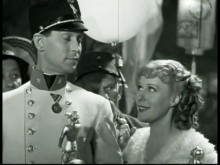
The King Steps Out (1936). Josef von Sternberg’s second—and final—film for Columbia stands unique in his filmography as the only film he specifically asked never be included in any retrospective of his work. It’s hard to understand why, since goodness knows it’s nowhere near as bad as Sergeant Madden (1938) or Jet Pilot (1957). It may, however, be the most frustrating of his works, because it’s very nearly good—and it would have been very good had the songs by Fritz Kreisler and Dorothy Fields been in the least bit memorable. Unfortunately, you forget them while you’re listening to them. (Rouben Mamoulian’s The Gay Desperado made the same year is almost in the same boat.) The idea of eschewing opera standards was a bad one. One thing Sternberg did pull of was to make Ms. Moore look a lot less like she could punch the crap out of her leading man than usual, but apparently the two didn’t get along. Really, this sort of frou-frou—a very candy box version of the romance of Emperor Franz Josef (a surprisingly good Franchot Tone) and Princess Elizabeth (Moore)—wasn’t Sternberg’s dish of tea. At best, it feels like ersatz Lubitsch, though it has elements of Rouben Mamoulian, too, and has some striking similarities to James Whale’s rarely seen By Candlelight (1934). On the other hand, the close-ups have the Sternberg look, and the carnival scenes are clearly his, even if you can’t help but realize they’d be a lot grander had he made the picture at Paramount. Alas, those days were over.
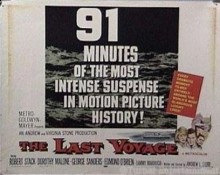
The Last Voyage (1960). The famous film in which director-producer Andrew L. Stone sort of sank the real Ile de France ocean liner. He didn’t really sink her—the old gal was being sold for scrap—and there’s a lot more effects jiggery-pokery than was thought, but the impression is pretty good. And, yeah, it pretty much is the start of the whole disaster movie genre. But this isn’t a very good movie. I saw it what seemed like innumerable times when I was a kid because it showed up as a filler title at our local movie house and my mother liked it (I never got why), so we kept going to it. I didn’t much like it then and I didn’t much like it this time. Dorothy Malone and Robert Stack have never been favorites of mine and this movie may be why. Malone spends most of the movie trapped in her cabin by—well, something that has to be cut away with an acetylence torch. Finding one, getting it to the cabin and getting it going takes nigh on to forever. I suppose it’s wrong of me, but watching Stack try to keep Malone’s head above water while Edmond O’Brien cuts her free—the suspense built by cutting away to other things and a narrator doing a portentious Cecil B. DeMille impersonation—is pretty darn funny. (Poor woman would have had a neck to rival Merle Oberon’s had he really pulled on it this much.) Woody Strode comes off best, followed by George Sanders as the pig-headed captain (seeing him crushed by a smokestack is a highlight). Huge downside: Tammy Marihugh as the imperiled daughter of the leads. Possibly the least appealing child star of all time.
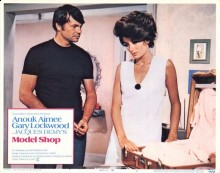
Model Shop (1969). Stupefyingly tedious late 1960s rubbish from French filmmaker Jacques Demy, who is here playing at being a Hollywood filmmaker. Why? I have no clue, but I’m grateful he didn’t do it again. The film mostly consists of personality-challenged Gary Lockwood driving around Los Angeles in his 1953 MG TD. Now, if you’re an MG fan—or just a Brit sports car enthusiast—Model Shop is probably the best look you’ll ever get at the classic TD in the movies. While this actually is one of my absolute favorite cars, it’s hardly the key to what you’d call dynamic drama. The plot—to the degree there is one—has Lockwood mired in a dying relationship with an equally personality-free generic blonde (Alexandra Hay) and about to have his MG repossessed. He drives around. He borrows the money to save his car. He blows the money on Anouk Aimee (playing her Lola character from Demy’s 1961 film Lola), a morose older woman who poses for cheesecake photos in a sleazy “model shop.” She, too, is untroubled by a personality. In the end, he finds out he’s been drafted, his girlfriend leaves him, Aimee goes back to Paris and his car gets towed. Some people seem to take this seriously, but really it’s a lousy chorus of “we’ll have angst, angst, angst till the car lot takes the MG away.”
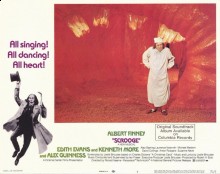
Scrooge (1970). The songs are abysmally bad (that no one ever shot Leslie Bricusse mystifies me), but Ronald Neame delivers—with the help of the great Brit cinematographer Oswald Morris—a very nice-looking film. Albert Finney is no Alastair Sim, and his Scrooge comes across as a kind of “playing dress-up.” I don’t for a minute believe in him. Alec Guinness—using his Gulley Jimson voice from The Horse’s Mouth (1958)—seems to be having a fine time playing Marley’s ghost as a kind of mincing old queen. Edith Evans makes an eccentric—sometimes downright peculiar—Ghost of Christmas Past. Kenneth More is a reasonable enough Ghost of Christmas Present, but not especially memorable. Quite the oddest thing about the whole movie is the addition of a hell sequence that looks like it’s out of an Italian horror picture—the only advantage to which is it affords more of Guinness mincing about.
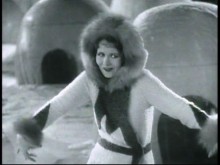
Sunnyside Up (1929). David Butler’s Sunnyside Up is probably best known (if not by name) for the excerpt from its notoriously pre-code musical number “Turn on the Heat” in the oddball documentary It Came from Hollywood (1982). The image gyrating chorus girls causing bananas to swell and ripen is not easily forgotten (and was often cut from TV prints). For early talkie fans, it’s known for introducing that song, “I’m a Dreamer, Aren’t We All?” and “If I Had a Talking Picture of You.” It also boasts one of the most amazing openings in early talkie history—an elaborate tracking shot down one side of a street (with up and down movements looking into apartment windows) and back up the other (with the same vignette approach). Most such shots in early sound movies are actually silent shots with a track added. This very obviously was done with live sound and it’s a remarkable accomplishment. Unfortunately, nothing else lives up to it, though the film has a quaint charm with its poor NYC girl (Janet Gaynor) falling for Long Island rich boy (Charles Farrell). However, there’s the drawback that neither Gaynor, nor Farrell can sing very well (and though he seems to have been, Farrell has a hard time convincing the viewer he’s a straight boy). And there’s the presence of Swedish dialect comedian El Brendel, which is never a plus, but he’s fairly subdued here as the poor slob who’s hopelessly in love with Gaynor.
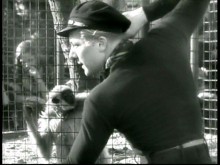
Zoo in Budapest (1933). Rowland V. Lee’s Zoo in Budapest is a true curio—a strange, poetic little film that seems out of place in its own time. It has far more in common with the art films being produced by Fox Film under William Fox in the late silent and very early sound era than it has with 1933. Indeed, it bears little resemblance to anything else I’ve ever seen from this director, and it feels for all the world like it ought to have been signed by Frank Borzage in its gauzy romantic lyricism. The story is at once simple and peculiar. Zani (Gene Raymond) lives and works in the Budapest zoo, apparently more in tune with animals than people. He seems to live in the cave in a disused bear enclosure—at least that’s where he hides orphan girl Eve (Loretta Young) when she runs away (more or less at Zani’s urging) to be with him. To complicate matters, there’s also a lost child (Wally Albright) wandering around, who inadvertently unleashes all the animals in the zoo’s central arena, which provides the film with its big climax. (And, truth to tell, it’s pretty spectacularly done, though in a way that would never be allowed by the humane society today.) Describing the film’s action does absolutely nothing to convey its mood or atmosphere. Since the film has no real star power by today’s standards, a director with no particular cache, and can’t be linked to much else, the likelihood of this ever getting a proper DVD release is pretty bleak. It does, however, show up on TCM from time to time and is worth catching.



It absolutely baffles me that he is highly regarded in some horror circles.
The appeal of most Italian horror escapes me.
Then again, this is the man who gave to the world a zombie fighting a shark on the ocean floor, so maybe his career wasn’t a total loss
Now, that I wouldn’t mind seeing, but I suspect it’s better to think about than actually watch.
Alright, I didn’t delete Mike’s post, which is what I was responding to.
The zombie vs. shark bit is pretty much the best part of Zombie, his unofficial companion piece to Romero’s …of the Dead series. It’s not a bad movie, really – still trashy “B” horror but not without its charm.
It’s really too bad there is so much awful Italian horror out there. While the risk of running across garbage like Cannibal Holocaust is high, unearthing gems like Suspiria and Black Sabbath almost makes an experience not dissimilar to cinematic Russian roulette worth the effort.
unearthing gems like Suspiria and Black Sabbath almost makes an experience not dissimilar to cinematic Russian roulette worth the effort
The problem for me is greater, because I’ve never found Suspiria a gem and am only on board for two of the episodes from Black Sabbath. There are too many things about Italian horror that generally don’t work for me (and which aren’t excused by the phrase “dream logic”). In fact, the only Italian horror picture that entirely works for me is Cemetery Man. That’s not to say that I don’t find some of it entertaining in its sheer loopiness.
Zombie does hang together fairly well. Most of Fulci’s stuff, like most Italian horror, is incoherent. I don’t think of it as “art” but more like “incompetence”. No American movie maker would get away with this sort of thing yet when the Italians do it people forgive it. I do like much of Argento’s and Bava’s and a few other’s works because they are largely coherent and don’t put style over narrative so much. A disjointed and randomly switching narrative is something I don’t care for in a horror movie. It’s horror, not a Beatles movie.
Now, the idea of Will Rogers doing Mark Twain is intriguing and possibly unique even if it’s not great. I’ll keep an eye out for it.
No American movie maker would get away with this sort of thing yet when the Italians do it people forgive it.
Mostly they excuse it as “dream logic” or art.
I do like much of Argento’s and Bava’s and a few other’s works because they are largely coherent and don’t put style over narrative so much
Boy, you’ve seen different Argento and Bava movies than I have. I like a few Argentos — mostly because they’re so utterly incoherent. Bava isn’t much better, though I’m apt to find him more tedious. I just watched Black Sunday again and it was visually impressive, but in terms of acting and story, I thought it close to moronic. (I know I’m supposed to think it’s a masterpiece.)
Now, the idea of Will Rogers doing Mark Twain is intriguing and possibly unique even if it’s not great. I’ll keep an eye out for it.
I think this is the first time TCM has shown it. I really don’t get why Fox hasn’t released this of all Rogers titles, especially since it was on VHS — and that version (unlike the copy they provided TCM) duplicated the original release prints by coloring Will Rogers pink when Myrna Loy kisses him.
Zombie does hang together fairly well. Most of Fulci’s stuff, like most Italian horror, is incoherent. I don’t think of it as “art” but more like “incompetence”. No American movie maker would get away with this sort of thing yet when the Italians do it people forgive it. I do like much of Argento’s and Bava’s and a few other’s works because they are largely coherent and don’t put style over narrative so much. A disjointed and randomly switching narrative is something I don’t care for in a horror movie. It’s horror, not a Beatles movie.
Now, the idea of Will Rogers doing Mark Twain is intriguing and possibly unique even if it’s not great. I’ll keep an eye out for it.
Maybe I should have qualified it as “coherent for Italian horror”. I was able to make sense of Deep Red, Suspiria, Sleepless, Blood and Black Lace, Black Sunday, and Danger: Diabolik. But I don’t seek out Italian horror particularly. And I wouldn’t consider any of them great. Still, compared to the rut that American horror has gotten into lately maybe a bit of Italian style incoherence would be an improvement. At least throw in a dwarf or two.
I love the songs in Scrooge…well, most of them anyway…. and Guinness didn’t mince. I really disliked the hell sequence, however, and am glad that it was excised from the TV version that I taped, many, many years ago.
I like life! Life likes me!
Maybe I should have qualified it as “coherent for Italian horror”. I was able to make sense of Deep Red, Suspiria, Sleepless, Blood and Black Lace, Black Sunday, and Danger: Diabolik.
If by coherent you mean you were able to follow the storyline, I’d agree. If you mean the story made much sense, then I wouldn’t. Actually, the coherence factor bothers me less than the lack of much in the way of a payoff. The endings of all of these I’m familiar with fall flat. Suspiria is probably the worst with its stab the ghost and that takes care of things. At least Argento’s Phenomena has a razor-brandishing chimp.
Still, compared to the rut that American horror has gotten into lately maybe a bit of Italian style incoherence would be an improvement. At least throw in a dwarf or two
I’m not quite as down on American horror (loosely defined) as you are. Such titles as The Ring, Seed of Chucky, Dead Silence, Silent Hill, Mirrors (I don’t care what anybody says), Midnight Meat Train, House of 1000 Corpses, Jeepers Creepers (both entries) and, for sheer style, feardotcom keep me from quite going there. Of course, it can be argued that Frenchmen made Silent Hill and Mirrors and a Japanese guy made Midnight Meat Train. Then again, a lot of classic Hollywood horror wasn’t made by Americans. I’d certainly concede that there’s also been a lot of crap, but that’s not exactly a recent development.
By the way, I’d have deleted your duplicate post, but the last time I did that in this thread, both posts disappeared. I’m gun-shy.
I love the songs in Scrooge
You’re allowed to.
I’ve had Sunny Side Up on the DVR ever since it aired but due to various Christmas gift DVDs I have yet to bother with it. I hazily recall seeing it on AMC about 15 years ago and was definitely not impressed. But then to me early talkie Fox is by and large a dreadful waste of time. How did Charles Farrell make any sort of transition to sound? John Gilbert was buried by MGM, yet this guy hung around for a while as a star?
Of course, considering I’ve got a box set of Preston Sturges coming in the mail Sunny Side Up might have to wait a bit longer, as it should.
But then to me early talkie Fox is by and large a dreadful waste of time.
It’s not exactly like they’re plentiful for reassessment.
How did Charles Farrell make any sort of transition to sound? John Gilbert was buried by MGM, yet this guy hung around for a while as a star?
It probably helped that there wasn’t a studio boss out to get Farrell, but God knows his sound performances are…well, they’re not good, though at least one film, Liliom, is worth it anyway.